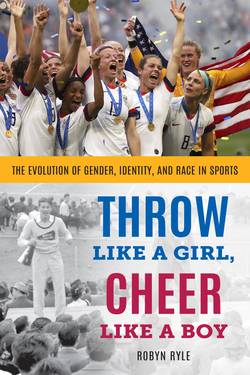Читать книгу Throw Like a Girl, Cheer Like a Boy - Robyn Ryle - Страница 26
На сайте Литреса книга снята с продажи.
Dora or Heinrich?
ОглавлениеThere is no corresponding story about the gender testing of male athletes because male athletes have never been tested for gender. Unlike “real” women who are seen as suspect if they succeed at sports, “real” men are expected to excel at sports. Assumptions about female and male athletic ability tell us that there’s no advantage to be gained by women trying to pass themselves off as men. All of the anxiety about sports and gender is directed at the phantom of the man passing himself off as a woman, but has that ever actually happened?
In the known history of international athletic competition, there’s only one documented case of a man passing himself off as a woman, and even this story is more complicated than it first appears. At the same 1936 Berlin Olympics where Helen Stephens was accused of being a man, Dora Ratjen took fourth place in the high jump event. Ratjen was later accused of being a man and quietly returned his medal. Ratjen claimed that Nazis had forced him to pose as a woman for three years, “for the sake of honor and glory of Germany.”[30] Dora’s real name was Heinrich, and when his story came out, it confirmed growing anxiety about gender fraud and international sports—despite the irony that Heinrich’s competitive advantage had only earned him fourth place, not a strong case for masculine superiority in sports.
For years, this story of Heinrich competing as Dora went unquestioned. Then in 2009, a German magazine reported on their investigation of Ratjen’s medical and police records. Apparently, Ratjen had been born with ambiguous genitalia, or as an intersex person, and his family raised him as a girl. Ratjen dressed in girl’s clothing and went to an all-girls school. He lived as a woman until two years after the 1936 Olympics. In 1938, Ratjen showed up in police records when he was arrested on a train for looking suspiciously like a man dressed in women’s clothes. With relief, Ratjen informed the police that though his parents had raised him as a girl, he long suspected he was really a man. A police physician examined Ratjen and agreed with his assessment—Ratjen was a man—but also noted that his genitals were atypical. Ratjen changed his name from Dora to Heinrich, but all of those details were unknown until recently.[31] Was Ratjen, then, a man passing as a woman?
It all depends on how you define gender, and that is the critical question for sports. If you use the criteria of Ratjen’s own internalized sense of who he is—his gender identity—then, yes, he was a man. We’ll never know whether Ratjen would have passed any of the many versions of gender tests that have come and gone since then. But his case demonstrates one reason why attempts to determine once and for all who is a woman and who is a man are always bound to fail. The reality of human biology, as well as how that biology interacts with the social world, is much more complex than any simple test can explain. Any attempts to sort athletes into neat categories of female and male are bound to fail.
What’s more, it is shortsighted to assume that the particular set of biological characteristics we think of as connected to gender are the most important in conferring athletic advantage. There are all kinds of ways in which some athletes are better equipped for their sports than others that have nothing to do with gender. Studies show that several elite runners and cyclists have rare conditions that give them extraordinary advantage when it comes to their muscles’ ability to absorb oxygen and their resistance to fatigue.[32] Some basketball players have a condition called acromegaly, a hormonal condition that results in very large hands and feet. This condition is surely a genetic advantage in the sport, but these players are not banned.[33] More baseball players have perfect vision compared to the average population, which allows them to see the ball better than the average person when they’re batting.[34] Some speculate that elite athlete Michael Phelps may enjoy competitive advantage from having Marfan syndrome, a rare genetic mutation that results in long limbs and flexible joints, two features that would provide quite the advantage in the pool.[35] In none of these sports are athletes tested for these conditions, which quite clearly confer competitive advantage. Why should hyperandrogenism be any different?
